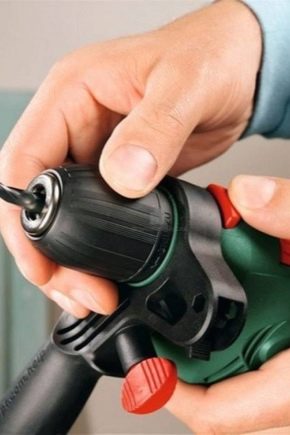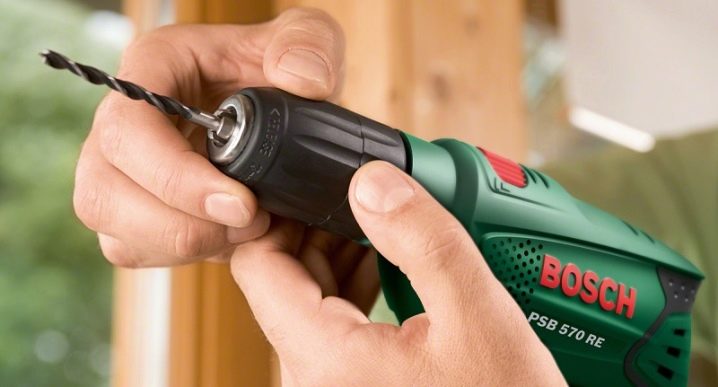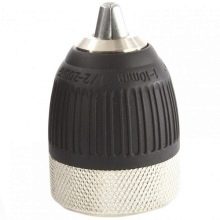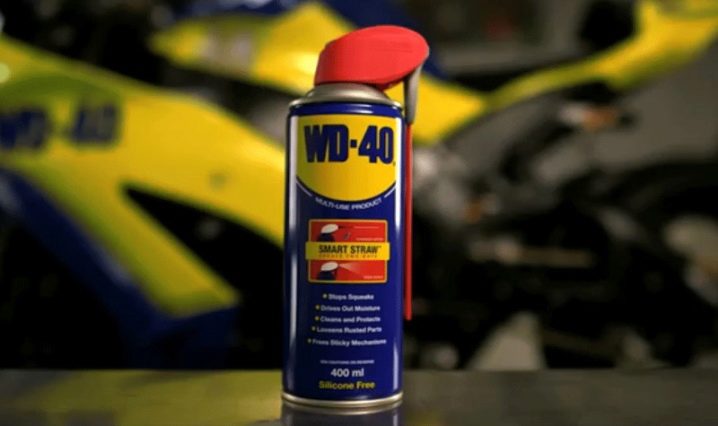How to remove and replace the chuck from the drill?

The chuck in the drill is one of the most exploited and, accordingly, quickly depleting its resource elements. Therefore, regardless of the frequency of use of the tool, sooner or later it fails. But this is not at all a reason to purchase a new drill - a worn-out chuck can simply be replaced with a new one. The procedure is simple and self-executable at home, if you adhere to certain rules and recommendations of experienced craftsmen.

What it is?
The chuck serves as a seat, a holder for the main working element of a drill or hammer drill. It can be not only a drill, but also a concrete drill for tools with an impact function, a special nozzle in the form of a Phillips or flat screwdriver. There are special drill bits designed for grinding, cleaning various surfaces. They are mounted on a round or multi-faceted pin, which also fits into the chuck.
Drill chucks differ in design and method of installation on the tool and are divided into three types:
- conical;
- gear-crown;
- quick-clamping.
Cone chuck
It was invented back in 1864 by the American engineer Stephen Morse, who also developed and proposed the use of a twist drill. The peculiarity of such a cartridge is that the working element is clamped due to the mating of two shaft surfaces and a separate part with a bore. The surfaces of the shafts and the hole for installing the drill have equivalent taper dimensions, the angle of which ranges from 1 ° 25'43 "to 1 ° 30'26".
The angle is adjusted by turning the base of the mechanism, depending on the thickness of the element to be installed.



Gear-ring design
A more common type of cartridge for hand held power tools for home use. The principle of such a cartridge is simple - a thread is cut at the end of the pin emerging from the drill, and the cartridge is screwed onto it like a nut.
The drill is held in the chuck by three tapered petals centered on the chuck in the collet. When the nut on the collet is turned with a special wrench, the petals come together and clamp the shank of the drill or other working element - a whisk for a mixer, a screwdriver bit, an impact chisel, a tap.


Keyless chuck
It is considered the most convenient option. This is the latest technological modification of this device in terms of the time of invention. It is used in almost all modern models of well-known drill manufacturers.
The working cutting or other element is also fixed by special petals, only a wrench is not required to clamp them. The fixing petals are clamped by hand - by turning the adjusting sleeve, on which corrugation is applied for ease of scrolling.
To prevent the sleeve from unwinding during the operation of the tool, an additional lock is provided at its base.



How to remove?
Since all types of drill chucks have their own design features, their dismantling also involves performing different actions. You will also need special tools.
Dismantling is possible with improvised or interchangeable means, but it is not recommended to experiment during the first disassembly, as the tool can be damaged.

In general, the procedure is not difficult and is quite feasible on your own at home.
Conical
The method of fastening the cartridge by the Morse method is one of the most reliable, but at the same time it does not provide for complex manipulations. The design perfectly withstands power loads along the axis in both conventional drills and tools with an impact function. That is why it is so widespread in manufacturing plants.
The cartridge is dismantled in several ways.
- It is necessary to strike with a hammer from below on the chuck body. The main thing is that the blow is directed along the axis towards the seat of the cutting element - the drill.
- Disconnect the chuck by wedging the surfaces: insert, for example, a chisel into the gap between the chuck and the drill body and, knocking it down with a hammer, carefully remove the shaft. In this case, it is very important not to hit in one place, so that the shaft does not skew: gradually pushing the chuck shaft, the chisel must be inserted in different places.
- Use a special puller such as the one used to remove the bearings.


In most hand drills with taper chuck, the shaft bearing is mounted inside the tool body. But there are also models where it is located outside. In this case, the removal should be done as carefully as possible, otherwise there is a possibility of damage to the bearing. If the shaft is too stuck and cannot be removed, do not hit it with a hammer with all your might.
In these cases, it is recommended to try to treat the surface with anti-corrosion agents - kerosene, aerosol preparation WD-40.

Gear-crown
The girth gear chuck is screwed onto a pin built into the drill. Accordingly, to dismantle the device, you just need to unscrew it in the opposite direction, but some nuances should be taken into account. The peculiarity of the threaded fastening of the cartridge is that the thread on the pin emerging from the drill is right-handed, and on the cartridge itself it is left-handed. Thus, during the operation of the tool, the chuck, turning clockwise, itself is automatically screwed on and tightened on the shaft.
This feature guarantees its reliable fixation on the drill, eliminates backlash and spontaneous vibration release of the element. This specificity of the fit of the cartridge should be taken into account when removing it - during the operation of the drill, the cartridge is screwed onto the axle until it stops, the thread is clamped with maximum force.
Therefore, in order to spin it back, you will need the following tools:
- wrench;
- Phillips or flathead screwdriver
- hammer;
- special wrench for clamping drills or chuck wrench.



Let's consider the order of performing actions.
- Using a special wrench for clamping the cutting element (drill), turn the collet counterclockwise to the stop and thus lower the locking lugs.
- Inside the chuck, if you look into it, there will be a mounting screw that holds the chuck on the seating shaft. It is necessary to unscrew this screw with a screwdriver, holding the shaft with an open-end wrench of the appropriate size. The head of the screw can be either a Phillips screwdriver or a flat - depending on the manufacturer. Therefore, it is best to prepare both instruments in advance.
- Then, firmly fixing the collet in one position (holding it with the teeth of the clamping nut), unscrew the chuck shaft with a wrench.
If the seating shaft is very stuck and the strength of the hands is not enough to turn the open-end wrench, it is recommended to use a vice. Clamp the wrench in a vise, push the shaft onto it, and insert and clamp the square head with the knob inside the collet.
While holding the drill with one hand, break the thread with light hammer blows on the collar. You can try to carry out the same operation without a vice - insert and clamp a square with a long handle in the collet (to increase the lever) and, firmly holding the shaft with an open-end wrench, turn it sharply counterclockwise.


Keyless
Depending on the manufacturer and model of the tool, keyless chucks are attached to the drill in two ways - they are screwed onto a threaded pin or fixed on special slots.
In the first case, it is removed in the same way as the gear-crown device:
- lower the clamping lugs;
- unscrew the locking screw;
- clamp a hexagon or a knob in the chuck;
- After fixing the base of the shaft, unscrew it with light hammer blows on the hexagon.
The second option with slots is used in modern devices and does not provide for the use of any tools for removal. Everything is done by hand in automatic mode easily and naturally. You just need to firmly grip the upper ring of the cartridge with your hand, and turn the lower one counterclockwise until you hear a click.
You can also navigate by special marks on the cartridge case. They indicate to what position the lower ring must be rotated to remove the device.


How to disassemble?
To disassemble the ring gear chuck, you need to fix it in a vice in a vertical position with the petals up. The clamping lugs or cams must first be lowered down to the stop. Then unscrew the toothed nut with an adjustable wrench, it is advisable to lubricate it with oil before that. When the clamping nut is unscrewed, remove the inner bearing and washer. Remove the product from the vice and unscrew the sleeve from the base.
There are models in which the base is not screwed in, but simply inserted into an external adjusting sleeve (jacket). Then the cartridge should be fixed in a vice in the same way, but only so that the sleeve passes between their jaws, and the edges of the coupling rest against them. Deepen the cams or petals as much as possible and unscrew the toothed nut. Put a gasket made of soft metal (copper, bronze, aluminum) on top, warm up the shirt with a construction hairdryer or blowtorch and knock out the case with a hammer.



Keyless chucks are much easier to disassemble, but they do not provide for a complete disassembly into all component parts.
To clean, check the insides of the element for damage or replace them, you must:
- firmly hold in your hand the part of the mechanism where the clamping jaws are located;
- insert a screwdriver into the slot between the couplings and carefully, turning the cartridge, separate and remove the lower plastic part of the case;
- deepen the petals as much as possible;
- insert a bolt of the appropriate size into the chuck and hammer the metal body assembly out of the second outer sleeve with a hammer.



It makes no sense to disassemble the keyless chuck further. Firstly, all places that need cleaning or lubrication will already be available. Secondly, further disassembly of the internal element is not provided for by the manufacturer and, accordingly, will lead to damage, failure of the entire mechanism.
Morse taper implies even less manipulation for disassembly... After dismantling the entire mechanism from the drill, it is necessary to clamp the outer metal sleeve (jacket) in a vice or hold it firmly with pliers. Then, using a gas wrench, pliers or a hexagon inserted inside, unscrew the clamping cone from the body.

How to change?
The Morse taper is mainly used on the equipment of mechanical engineering enterprises. But some manufacturers equip hand drills and hammer drills for private, home use with such a design. The cone chuck is marked with a letter and numbers. For example, B12, where B conventionally denotes the name of the cone, and the number 12 is the size of the diameter of the shank of the working element, for example, a drill.
These indicators must be taken into account when replacing.
To change such a cartridge, you need to knock it off the drill with a hammer or a special puller. The new product is installed by fitting its rear side onto the tapered shaft.

The gear-crown chuck is used in the manufacture of not only home, but also professional construction drills designed for serious loads and a long service life. When uninterrupted, practically non-stop operation of the tool for several hours is important - when assembling various building structures, furniture, machine tools. Therefore, it provides for quick replacement so that workers do not waste a lot of time. You just need to unscrew the shaft of the worn mechanism from the pin mounted in the drill body and screw in a new cartridge in its place.
Keyless chuck changes the fastest. Guided by the pointers on the body, you just need to fix its upper part with your hand and turn the lower one until you get a characteristic click.
The new product is mounted in the reverse order - put on the splines and clamped by turning the locking sleeve.



Possible cartridge problems
Any device, no matter how high quality it may have, wears out over time, is produced and fails. Drill chucks are no exception. Most often, the cause of the breakdown is the wear of the petals holding the drill - their edges are erased, this causes beating, and there is a backlash of the working element. No less the problem of turning the drill while pressing it against the work surface is often encountered. Such a malfunction indicates wear of the seating thread or the development of a tool taper., depending on the type of mechanism.
There are many other malfunctions when the chuck is jammed or jammed.
In any case, at the first violations of normal operation, it is necessary to stop using the tool and identify the cause. Otherwise, there is a risk of bringing the mechanism to a state where repair is no longer possible, and a complete replacement of the entire element will be required, which will cost much more.

You will learn how easy it is to remove the chuck of a drill or screwdriver in the next video.













The comment was sent successfully.